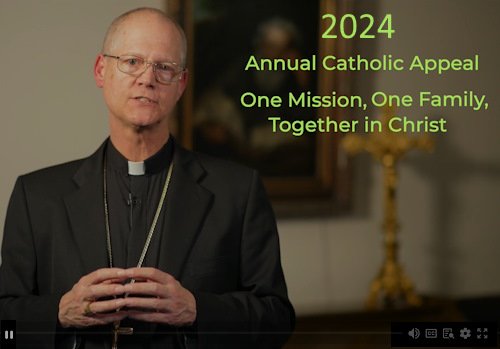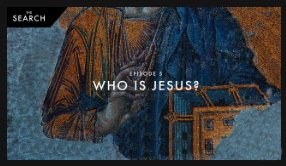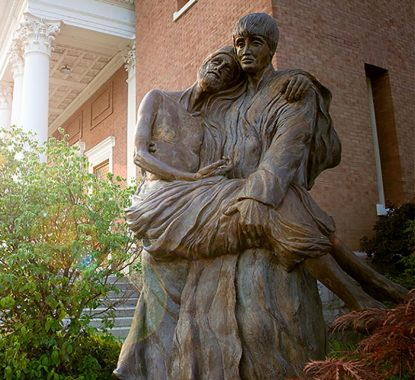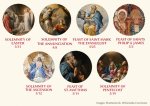MASS SCHEDULE
Tue & Thu & Sat - 8:30am
Sat - 5:00pm
Sun - 10:30am
Holy Days
Check bulletin/website for details
First Thursday
8:30am followed by Adoration until 10:00am
Rosary - Starts 30 min. before mass
Reconciliation
Sat - 4:00pm - 4:45pm
First Tues - 9:15am -10am
Address
211 West Mason Ave.
Buckley, WA 98321
Phone: 360-829-6515
Office Hours
Tue - Fri 9:30am - 1:30pm
Map it
Our church and bathrooms are wheel chair accessible.
If you have a prayer request, please go here and it will be presented to the priest so he can remember your request in his private mass.
PARISH STEWARDSHIP
RENEWAL
Your Stewardship pledge is just one way we express our discipleship as followers of Jesus Christ. As disciples of Jesus Christ, our response to God’s abundant generosity is one of immense gratitude. Your Stewardship of Treasure renewal for the coming year supports St. Aloysius and continues the mission that defines who we are and what we do. Please return your 2023 pledge card today in the collection basket, to the parish office, through the mail or go online here to complete your pledge.
ACA 2024
We exceeded our 2023 ACA goal! Information from 2023 campaign: goal $25,010 payments $32,226, average gift $416, rebate for 2023 estimated at $7,746
Why support the Annual Catholic Appeal? Your donation supports Catholic parishes and outreach ministries like Mental Health, Grief, Inclusion for people with different abilities, Prison ministry, Hospital chaplains, Seafarer ministries, and many more.
Hear directly from ministry leaders about how the Annual Catholic Appeal keeps ministries alive and thriving across the Archdiocese of Seattle.
You can make a donation or make a payment on ACA2024 here...
Contact the office: 360-829-6515
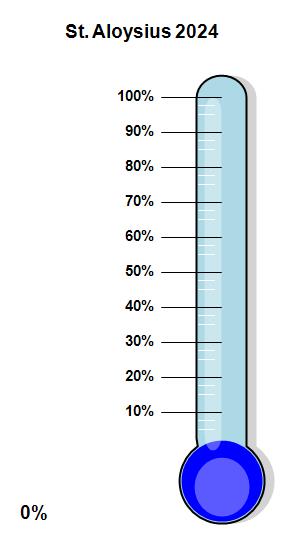
Goal: $24,908.00
Pledged:
Percent of Goal: %
Participation: %
Possible rebate after all
pledges are paid:
Total received over goal
to fund our parish project:
Thank you for your generous support of the Annual Catholic Appeal. We couldn’t do it without you. If you haven’t donated, there is still time. Go here to give today...

Helping To End The Injustice Of Abortion
PRAYER & FASTING
Each day during 40 Days for Life, individuals, churches, families, and groups will be asked to join together in prayer for a specific request so the entire Body of Christ can unite around a common focus.
CONSTANT VIGIL
The visible, public centerpiece of 40 Days for Life is a focused, 40-day, non-stop, round-the-clock prayer vigil outside a single Planned Parenthood center or other abortion facility in your community.
COMMUNITY OUTREACH
During 40 Days for Life, the message is taken proactively to every corner of your community. Media outreach is conducted through carefully targeted news stories, talk shows, and editorials. Church involvement begins by meeting with local pastors, other church leaders, and members of different congregations.
Go here to become involved with 40 Days for Life...
CALLED TO SERVE as CHRIST
CAMPAIGN
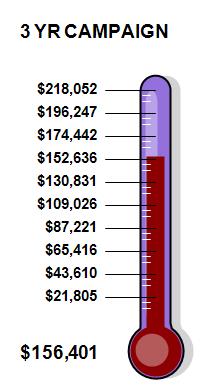
GOAL: $218,052.00
PLEDGED: $175,496.00
2018-2021
Thank you for pledging $175,496 towards our GOAL of $218,052.00. Total cash received towards goal our is 72%, $156,401.00. St. Aloysius has received 15% of this amount, and once we reach the GOAL, our rebate will increase to 85%! Thank you for your generosity and for continuing to make donations to fulfill your pledge.
FORMED.org
The Catholic Faith on Demand
(only works in Chrome, Firefox, MS Edge)
Please utilize our parish's subscription to FORMED.org
FORMED.org is a revolutionary
online platform that provides access to the best Catholic audio talks,
movies, ebooks, and video based studies from trusted providers like the
Augustine Institute, Ignatius Press, Catholic Answers, the Knights of
Columbus, St. Paul Center, Sophia Press and more!
We
are excited to announce that our parish has subscribed to an exciting
new online platform. Create a personal account and start enjoying the
best Catholic content all in one place! Catholic Content including
movies, lectures, books children's' programming and more - and It’s
Free!
FORMED.org provides amazing content 24/7 for you to grow in your faith. It’s FREE and now EASIER THAN EVER to Register!
- Go to formed.org and click on sign up (only works in Chrome, Firefox, and MS Edge).
- Select - I belong to a Parish or Organization.
- Select your parish (using zip 98321 is quicker).
- Register with your name and email address.
- Check that email account for a link to begin.
- Contact the office with questions.
Forgiven: The Transforming Power
of Confession
Forgiven: The Transforming Power of Confession, explores the grace and healing offered in Confession and shows how this sacrament of mercy reveals the depth and bounty of God's love. By looking at God's revelation of his mercy in Scripture and making a step-by-step examination of the Rite itself, Forgiven communicates God's invitation to each one of us to come experience his indescribable love in the Sacrament of Reconciliation. The season of Advent is a perfect time for spiritual renewal through encountering God’s mercy in the Sacrament of Reconciliation.
Presence: The Mystery of the Eucharist
Although the Eucharist appears to be simple bread and wine, it is actually the "source and summit" of the Christian life. Presence: The Mystery of the Eucharist explores the truth and beauty of Christ's real presence in the Eucharist, from its origins in Sacred Scripture, to its profound role in the life of the Church and her members. Go here to see the crescendo of the entire story of salvation.
St. Joseph: Our Spiritual Father
While the Gospel has not preserved any of his words, his actions have resounded through the ages. Joseph of Nazareth stands out as the model par excellence of Christian virtue, a brilliant example of obedience to God and trust in Divine Providence. His role as protector of families in the difficulties of life and Patron of the universal Church has never been more clearly needed. Now, the Church is seeking to deepen its understanding of the Guardian of Jesus and of the Holy Family. Featuring interviews with leading experts and theologians, in addition to powerful first-hand testimonials — St. Joseph: Our Spiritual Father provides viewers with a glimpse into one of the most incredible lives in all of human history — a figure whose spiritual fatherhood remains open to all of us. Watch here...
Consecration to Saint Joseph
The Augustine Institute Show - 03/15/22 - Fr. Donald Calloway
How do Catholics make a consecration to Saint Joseph? Ben Akers fills in for Tim Gray on this week's episode of the Augustine Institute Show to celebrate Saint Joseph! Father Donald Calloway, author of Consecration to Saint Joseph, will discuss ways we can grow in our relationship with this powerful saint. Watch here...
THE SEARCH
The Search // Episode 5 // Who is Jesus? The most beautiful part of this story is this we can know God's love, personally. This is the person of Jesus. But how did this seemingly insignificant carpenter born into poverty in a dusty corner of the Roman Empire become the most pivotal figure in all of history? Christianity isn’t simply a philosophy for life – the center of Christianity is a person. We look at the life of Jesus and what he came to do. Ultimately, we need to decide if Jesus really was who he said he was. We can’t sit on the fence. Because if Jesus really was who he said he was, we need to make him the Lord of our lives, and everything changes.
Watch now...

The Search // Episode 6 // Am I Saved? What Jesus did for us through his life, death and resurrection was the greatest act of love in history. He saved us. He did this for each one of us. Personally. But some might feel unworthy of this gift of love. We may feel we have too much baggage. We may feel unlovable. But God didn’t come to reveal himself to us on a pedestal, he came to enter into our messy human condition. To fix us from within. To transform us from the inside out. Some might be surprised by how generous the love of God really is. We don’t deserve God’s love, but that’s the amazing reality of God’s mercy. This relationship with God isn’t all about our love for Him. It’s about His love for us that changes our lives forever.
Watch now...
Archbishop Etienne Blog
Preaching is a priority to Archbishop Etienne's episcopal ministry. His blog is an effort to engage and serve you, God's faithful people. Enjoy your visit! https://www.archbishopetienne.com/
Please
go here to read the recent Pastoral Letter from Archbishop Etienne -
The Work of Redemption, Eucharistic Belief and Practice in the
Archdiocese of Seattle
Pray the Rosary with the Archdiocese of Seattle from Archdiocese of Seattle
Please visit the Northwest Catholic pertaining to Archbishop Etienne voting against U.S. bishops’ proposed document on the Eucharist
Prayer for Spiritual Communion
My Jesus, I believe that you are present in the most holy Eucharist. I love you above all things, and I desire to receive you into my soul. Since I cannot at this moment receive you sacramentally, come at least spiritually into my heart. I embrace you as if you were already there and unite myself wholly to you. Never permit me to be separated from you. Amen.
St. Aloysius Pray For Us!
A statue of St. Aloysius Gonzaga carrying a plague victim in his arms is seen on the campus of Gonzaga University in Spokane, Wash. (CNS photo/courtesy Gonzaga University). Read more here...
NORTHWEST CATHOLIC is a gift of faith to every registered Catholic household in Western Washington. If you are currently registered at our parish you will receive NORTHWEST CATHOLIC at no charge. Questions? Call 206-382-4850 or 1-800-473-5641.
CELEBRATING 125 YEARS!
In 2017 St. Aloysius celebrated 125 years of religious service for Buckley, WA and its surrounding areas.
PARISH NEWS
Sign up to receive Parish News
This is kept private!
Follow St. Aloysius Blog...
Recent Articles
-
Apr 18, 24 07:06 PM
St. Aloysius Catholic Church welcomes you to come and celebrate the Roman Catholic Mass and enjoy Catholic fellowship while growing in your Catholic Faith.
Read More
-
Apr 18, 24 06:54 PM
Annual Catholic Appeal for St. Aloysius Catholic Church of Buckley, Washington.
Read More
-
Apr 18, 24 06:08 PM
Catholic Bulletin 2024 for St. Aloysius Catholic Church of Buckley, WA
Read More
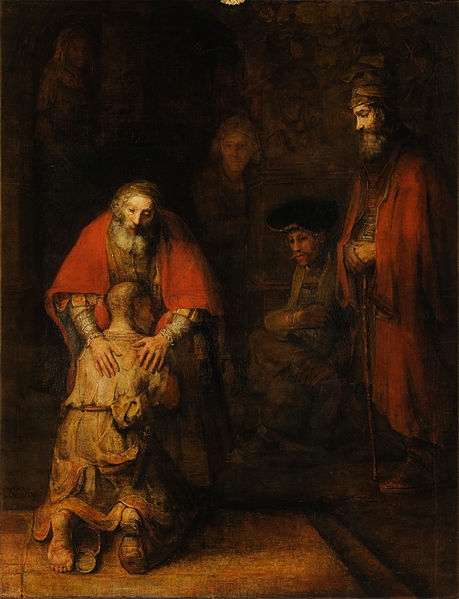 Rembrandt - The Return of the Prodigal Son
Rembrandt - The Return of the Prodigal Son

